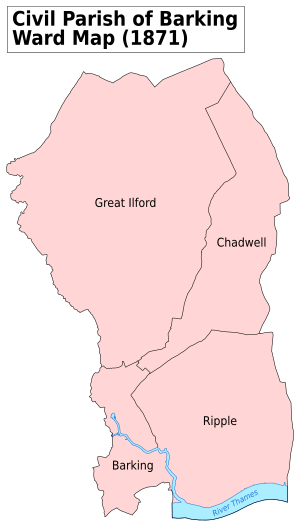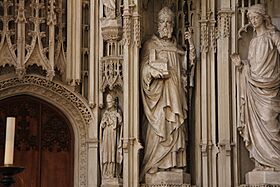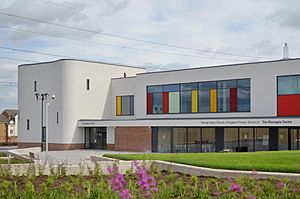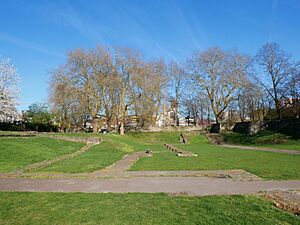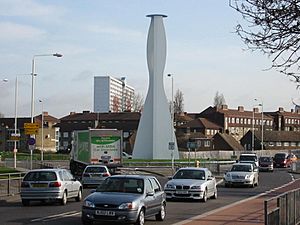Barking, London facts for kids
Quick facts for kids Barking |
|
|---|---|
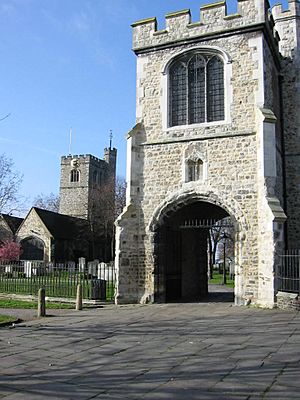 Barking Abbey curfew tower with St Margaret's Church in background |
|
| Population | 59,068 (2011 census) |
| OS grid reference | TQ440840 |
| • Charing Cross | 10 mi (16 km) W |
| London borough | |
| Ceremonial county | Greater London |
| Region | |
| Country | England |
| Sovereign state | United Kingdom |
| Post town | BARKING |
| Postcode district | IG11 |
| Dialling code | 020 |
| Police | Metropolitan |
| Fire | London |
| Ambulance | London |
| EU Parliament | London |
| UK Parliament |
|
| London Assembly | |
Barking is a town located by the river in East London, England. It is part of the London Borough of Barking and Dagenham. Barking is about 15 kilometers (9.3 miles) east of Charing Cross, a central point in London. In 2011, about 59,068 people lived in Barking.
Barking has many homes and a busy town centre with shops and businesses. This area is currently being updated and improved. Old industrial areas to the south are being turned into a new place called Barking Riverside.
Long ago, Barking was an old parish (a type of local area) in Essex, located by the River Roding. Over time, it changed from a place known for fishing and farming to one with market gardens and factories along the River Thames. Barking railway station opened in 1854, and the London Underground started serving it in 1908. As London grew in the 20th century, Barking became much bigger and its population increased. This was mainly because of the London County Council building many homes in Becontree in the 1920s. Barking became a borough in 1931 and part of Greater London in 1965.
Contents
- History of Barking
- What Does the Name Barking Mean?
- Barking's Manor History
- How Local Government Changed
- Modern Local Government in Barking
- Barking Abbey: A Historic Nunnery
- Barking's Market History
- Historic Buildings in Barking
- Fishing Industry in Barking
- Women's History in Barking
- Barking's Economic Growth
- The Thames Disaster of 1878
- Economy and Shopping
- Geography of Barking
- People and Population
- Education in Barking
- Transport in Barking
- Culture and Arts
- Notable People from Barking
- See also
History of Barking
What Does the Name Barking Mean?
The name Barking comes from an old English word, Berecingas. This word either meant "the settlement of the followers of a man named Bereca" or "the settlement by the birch trees." In the year 735 AD, the area was called Berecingum, meaning "dwellers among the birch trees." By 1086 AD, it was known as Berchingae, as recorded in the Domesday Book.
Barking's Manor History
Barking was once a very large landholding, or "Manor." It was first mentioned in a document in 735 AD, though Barking Abbey (a nunnery) is thought to have been founded even earlier, in 666 AD. This Manor included the areas we now know as Barking, Dagenham, and Ilford. The land was owned by the nuns of Barking Abbey.
The Fanshawe family was important in the area. They were the lords of the Manor of Barking from 1628 to 1857. They lived in several large houses in the borough, like Valence House.
How Local Government Changed
For about 700 years, starting in the late 1100s, the local areas called "Parishes" in England mostly stayed the same. The huge Manor of Barking was served by two old parishes: Barking and Dagenham.
The Parish of Barking was very large, covering about 50 square kilometers (12,307 acres). It included the areas now known as Barking and Ilford. In 1888, Ilford was separated to form its own parish.
Modern Local Government in Barking
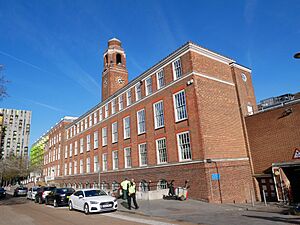
In 1894, the parish became the Barking Town Urban District. This district became the Municipal Borough of Barking in 1931. In 1965, it was split up. Most of it joined with the area of Dagenham to create the London Borough of Barking and Dagenham. The part west of the River Roding became part of the London Borough of Newham. In 1980, the borough was renamed Barking and Dagenham.
Barking Abbey: A Historic Nunnery
The Manor of Barking was home to Barking Abbey, a nunnery founded in 666 AD by Eorcenwald, who was the Bishop of London. It was later destroyed by the Danes but rebuilt in 970 AD by King Edgar. The famous writer Marie de France might have been the abbess (head nun) there in the late 1100s.
When monasteries were closed down in 1536, Barking Abbey was torn down. Today, only the parish church of St Margaret, some walls, and foundations remain. St Margaret's Church is an example of Norman architecture. Captain James Cook was married there in 1762.
Barking's Market History
Barking has had a market for a very long time. A document from between 1175 and 1179 confirmed its right to hold a market. The market became less active in the 1700s but has since been brought back to life.
Historic Buildings in Barking

St Margaret's Church is a very old and important building in the Abbey Green area. It dates back to the 1200s. It stands within the grounds of Barking Abbey. The ruins of the Abbey include the partially restored Curfew Tower, which is featured on the coat of arms of the London Borough of Barking and Dagenham.
Eastbury Manor House in Barking is another important historic building. It's a 16th-century Elizabethan manor house and museum run by the National Trust.
Fishing Industry in Barking
Fishing was Barking's most important industry from the 1300s until the mid-1800s. Fishermen sailed far, even to Iceland in the summer, to catch fish. They supplied the Billingsgate Fish Market in London.
Around 1870, the fishing fleet started using larger boats called ketches that could stay at sea for months. To keep the fish fresh, they used ice made by flooding local fields in winter.
By 1850, there were about 220 fishing boats, employing around 1,370 men and boys. These boats were typically 23 meters (75 feet) long and could carry up to 50 tons of fish.
The fishing industry in Barking began to decline in the second half of the 1800s. This was partly because new rail links made it faster to transport fish by train from North Sea ports directly to London. Also, by the 1850s, the River Thames was so polluted that fish kept in holding chests would quickly die. A big storm in December 1863, which killed 60 men, also hurt the industry. Many fishing companies moved to other ports like Great Yarmouth and Grimsby. By 1900, Barking was no longer a fishing port. Today, only street and pub names, and a large sculpture called "The Catch," remind people of this history.
Women's History in Barking
Barking Abbey was a nunnery founded in the mid-600s by St Erkenwald. His sister, St Ethelburga, was the first Abbess. Until it was closed by King Henry VIII in 1539, the Abbey was a major center for women's learning.
The famous writer Mary Wollstonecraft, who wrote "A Vindication of the Rights of Women," lived in Barking for some of her childhood. She was born in Spitalfields in 1759, and her family moved to Barking when her father tried to become a farmer.
Annie Huggett, who lived to be 104 and passed away in 1996, was a well-known local activist for women's right to vote, known as a Suffragette. She was the last living Suffragette. The Gospel Oak and Barking Overground railway line is now called the "Suffragette Line" in her honor.
Barking's Economic Growth
Boat building has a long history in Barking, even being used to repair some royal ships for Henry VIII. By 1848, many people worked in boat building and related trades. Other industries replaced the nautical ones, including jute spinning and making paint and chemicals.
From 1925 until the 1970s, a large power station called Barking Power Station operated at Creekmouth, burning coal brought in by river. In the 20th century, new industrial areas were built, and many local people found jobs at the car plant in Dagenham.
The Thames Disaster of 1878
On September 3, 1878, a terrible accident happened on the River Thames. The ship Bywell Castle crashed into a pleasure steamer called Princess Alice near Barking Creek. The Princess Alice was returning from a trip with almost 800 people. It broke in two and sank quickly, causing the loss of over 600 lives. This was the largest loss of civilian lives in UK waters. After this disaster, new rules were made to improve safety on the Thames.
Economy and Shopping
The Vicarage Field Shopping Centre is located in Barking town centre. It opened in November 1990 and offers many shops for residents.
Geography of Barking
Barking is about 15 kilometers (9.3 miles) east of central London. It is next to Ilford to the north, Dagenham to the east, and East Ham to the west.
Barking Town Centre Updates
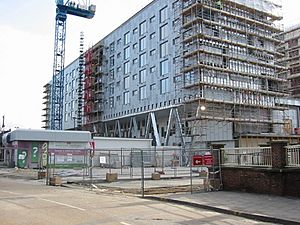
Barking Town Centre is being updated with many new projects. The goal is to create a stronger economy by adding new shops and a business center. This will also create more job opportunities for people living there.
A key part of this plan is the Barking Learning Centre. This center helps people improve their reading, writing, and other basic skills. It was officially opened in June 2008.
The town centre development also aims to improve housing. Plans included building 4,000 new homes, with many being affordable for local residents. A new town square was completed in 2008 and has won an award for urban public space.
Roding Riverside Area
Roding Riverside is an area in Barking located along the River Roding / Barking Creek. This area used to be industrial. Many buildings are new homes and businesses, but some old Victorian factory buildings have been turned into art galleries and leisure spaces. This helps bring new life to the area while keeping its industrial history.
One of these old buildings is a former Malthouse. Nearby, there's a group of buildings called the Ice House Quarter, which includes a former Ice House and a Boat House. A new building, Ice House Court, also provides space for artists.
Barking Riverside Development
The Barking Riverside project is a huge development that is changing the Thames riverside area of East London. It involves building new homes, creating jobs, and providing services. The area is about 1.4 square kilometers (350 acres) of former industrial land.
Construction started in 2008, and the project is expected to be finished around 2025. About 10,000 homes are being built, which will house around 25,000 people. New transport links have been added, including the East London Transit and an extension of the Docklands Light Railway to Barking Riverside DLR station. The Gospel Oak to Barking line of the London Overground was also extended to Barking Riverside, completing in 2022.
The development also includes new public facilities. Two new primary schools and one secondary school are being built. People will also have access to two kilometers of the Thames riverfront. The Rivergate Centre provides community facilities for the first part of Barking Riverside.
 |
Woodgrange Park | Ilford & Loxford | Mayesbrook Park |  |
| East Ham | Upney | |||
| North Beckton | Beckton | Creekmouth |
People and Population
In recent years, Barking's population has become more diverse due to people moving there from different countries. There are growing communities from South Asia and Africa. Local businesses and places of worship, like churches, mosques, and gurdwaras, show this diversity.
According to the 2011 census, the largest ethnic groups in Barking's town center (Abbey ward) were Pakistani (17%), White British (16%), Black African (15%), Indian (13%), and Other White (11%).
Barking's population has grown steadily since the late 1800s. In 2011, the population of the main Barking wards was 48,340.
| 1881 (may include Ilford) | 16,848 |
|---|---|
| 1891 | 14,301 |
| 1901 | 21,547 |
| 1911 | 31,294 |
| 1921 | 35,523 |
| 1931 | 51,270 |
| 1941 | # |
| 1951 | 78,170 |
| 1961 | 72,293 |
| # no census was held due to war | |
| source: UK census | |
Education in Barking
Barking has several primary schools, including Northbury Primary School, Eastbury Primary School, St Margaret's Church of England, and St Joseph's Roman Catholic.
For secondary education, there is Barking Abbey School. Lady Aisha Academy is an independent Muslim Girls Secondary School that opened in September 2011.
Transport in Barking
Barking is mostly located north of the A13 road and east of the River Roding. The Thames View Estate and Barking Riverside are south of the A13. The A406 North Circular Road runs through the Roding Valley.
Barking station is a major transport hub. It is served by the London Underground, London Overground, c2c trains, and London Bus and East London Transit routes. The eastern part of Barking is served by Upney Underground station. The area south of the A13 is served by Barking Riverside railway station. The East London Transit bus system has a station near the Vicarage Field Shopping Centre.
The western end of the Yiwu-London railway line, which connects China to the UK, is located in Barking at the DB Eurohub. The first train service on this line arrived in January 2017.
Culture and Arts
Music Connections
Neil Young recorded two songs for his famous album Harvest at the Barking Assembly Hall (now the Broadway theatre) in 1972.
The electronic music group Underworld named their 2010 album Barking after the town. The artist Ramz also released a popular song called "Barking" in 2017.
Local Media
Bedrock is a local hospital radio service. It is available online and provides health-related information, focusing on the local King George Hospital and Queen's Hospital.
The Barking & Dagenham Post provides local news both in print and online.
Sports in Barking
Barking F.C. is a local non-league football team. Barking RFC is the town's rugby union team. Cricket, basketball, and hockey are also popular sports in the area. A Parkrun event takes place in Barking Park.
Public Artworks
Barking Town Centre has several recently added sculptures and public artworks.
In 2007, two small stones from the old London Bridge were used in a sculpture in front of St Margaret's church, facing the Barking Abbey ruins. This was part of several public artworks placed in Barking Town Centre by artist Joost Van Santen.
Notable People from Barking
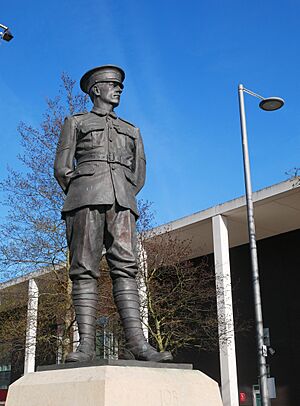
Many famous people have come from Barking. These include former England football captains and defenders Bobby Moore and John Terry. The successful racing driver Scott Malvern was born in Barking Hospital. Jason Leonard, who played rugby union for England 119 times, was born in Barking and started his career at Barking RFC.
The singer-songwriter and activist Billy Bragg was born in Barking, as was U2 guitarist The Edge, and singer Megan McKenna.
Actor Danny Lee Wynter was also born in Barking.
See also
 In Spanish: Barking para niños
In Spanish: Barking para niños
- List of people from Barking and Dagenham
- List of schools in Barking and Dagenham



